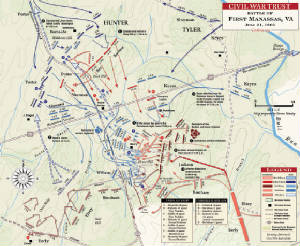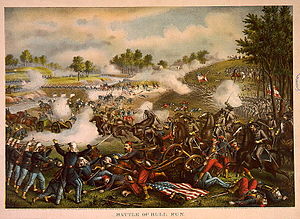|
Colonel William T. Sherman’s Official Report for the Battle of First Manassas
| First Battle of Manassas Map |

|
| 1st Battle of Manassas Map |
HDQRS. THIRD BRIGADE, FIRST DIVISION,
Fort Corcoran, July 25, 1861.
Capt. A. BAIRD,
Assistant Adjutant-General,
First Division.
SIR: I have the honor
to submit this my report of the operations of my brigade during the action of the 21st instant. The brigade is composed of
the Thirteenth New York Volunteers, Colonel Quinby; Sixty-ninth New York, Colonel Corcoran; Seventy-ninth New York, Colonel
Cameron; Second Wisconsin, Lieutenant-Colonel Peck, and Company E, Third Artillery, under command of Capt. R. B. Ayres, Fifth
Artillery. We left our camp near Centreville, pursuant to orders, at 2.30 a.m., taking place in your column next to the brigade
of General Schenck, and proceeded as far as the halt before the enemy's position near the stone bridge at Bull Run. Here the
brigade was deployed in line along the skirt of timber, and remained quietly in position till after 10 a.m. The enemy remained
very quiet, but about that time we saw a regiment leave its cover in our front and proceed in double-quick time on the road
toward Sudley Springs, by which we knew the columns of Colonels Hunter and Heintzelman were approaching. About the same time
we observed in motion a large force of the enemy below the stone bridge. I directed Captain Ayres to take position with his
battery near our right and open fire on this mass, but you had previously detached the two rifled guns belonging to this battery,
and finding the smoothbore guns did not reach the enemy's position we ceased firing, and I sent a request that you should
send to me the 30-pounder rifled gun attached to Captain Carlisle's battery. At the same time I shifted the New York Sixty-ninth
to the extreme right of the brigade.
Thus we remained till we heard the musketry fire across Bull Run,
showing that the head of Colonel Hunter's column was engaged. This firing was brisk, and showed that Hunter was driving before
him the enemy till about noon, when it became certain the enemy had come to a stand, and that our forces on the other side
of Bull Run were all engaged----artillery and infantry. Here you sent me the order to cross over with the whole brigade to
the assistance of Colonel Hunter. Early in the day, when reconnoitering the ground, I had seen a horseman descend from a bluff
in our front, cross the stream, and show himself in the open field, and, inferring we could cross over at the same point,
I sent for ward a company as skirmishers, and followed with the whole brigade, the New York Sixty-ninth leading. We found
no difficulty in crossing over, and met no opposition in ascending the steep bluff opposite with our infantry, but it was
impassable to the artillery, and I sent word back to Captain Ayres to follow if possible, otherwise to use his discretion.
Captain Ayres did not cross Bull Run, but remained with the remainder of your division. His report, herewith, [No. 27], describes
his operations during the remainder of the day.
Advancing slowly and cautiously with the head of the
column, to give time for the regiments in succession to close up their ranks, we first encountered a party of the enemy retreating
along a cluster of pines. Lieutenant-Colonel Haggerty, of the Sixty-ninth, without orders, rode out and endeavored to intercept
their retreat. One of the enemy, in full view, at short range, shot Haggerty, and he fell dead from his horse. The Sixty-ninth
opened fire upon this party, which was returned; but, determined to effect our junction with Hunter's division, I ordered
this fire to cease, and we proceeded with caution toward the field, where we then plainly saw our forces engaged. Displaying
our colors conspicuously at the head of our column, we succeeded in attracting the attention of our friends, and soon formed
the brigade in rear of Colonel Porter's. Here I learned that Colonel Hunter was disabled by a severe wound, and that General
McDowell was on the field. I sought him out, and received his orders to join in the pursuit of the enemy, who was falling
back to the left of the road by which the Army had approached from Sudley Springs. Placing Colonel Quinby's regiment of rifles
in front, in column by divisions, I directed the other regiments to follow in line of battle, in the order of the Wisconsin
Second, New York Seventy-ninth, and New York Sixty-ninth.
Quinby's regiment advanced steadily down
the hill and up the ridge, from which he opened fire upon the enemy, who had made another stand on ground very favorable to
him, and the regiment continued advancing as the enemy gave way, till the head of the column reached the point near which
Ricketts' battery was so severely cut up. The other regiments descended the hill in line of battle under a severe cannonade;
and the ground affording comparative shelter against the enemy's artillery, they changed direction by the right flank and
followed the road before mentioned. At the point where this road crossed the ridge to our left front, the ground was swept
by a most severe fire of artillery, rifles, and musketry, and we saw in succession several regiments driven from it, among
them the zouaves and battalion of marines.
Before reaching the crest of this hill the roadway was worn
deep enough to afford shelter, and I kept the several regiments in it as long as possible; but when the Wisconsin Second was
abreast of the enemy, by order of Major Wadsworth, of General McDowell's staff, I ordered it to leave the roadway by the left
flank, and to attack the enemy. This regiment ascended to the brow of the hill steadily, received the severe fire of the enemy,
returned it with spirit, and advanced delivering its fire. This regiment is uniformed in gray cloth, almost identical with
that of the great bulk of the secession army, and when the regiment fell into confusion and retreated toward the road there
was an universal cry that they were being fired on by our own men. The regiment rallied again, passed the brow of the hill
a second time, but was again repulsed in disorder.
By this time the New York Seventy-ninth had closed
up, and in like manner it was ordered to cross the brow of the hill and drive the enemy from cover. It was impossible to get
a good view of this ground. In it there was one battery of artillery, which poured an incessant fire upon our advancing columns,
and the ground was very irregular, with small clusters of pines, affording shelter, of which the enemy took good advantage.
The fire of rifles and musketry was very severe. The Seventy-ninth, headed by its colonel (Cameron), charged across the hill,
and for a short time the contest was severe. They rallied several times under fire, but finally broke and gained the cover
of the hill.
This left the field open to the New York Sixty-ninth, Colonel Corcoran, who in his turn
led his regiment over the crest, and had in full open view the ground so severely contested. The firing was very severe, and
the roar of cannon, muskets, and rifles incessant. It was manifest the enemy was here in great force, far superior to us at
that point. The Sixty-ninth held the ground for some time, but finally fell back in disorder.
All this
time Quinby's regiment occupied another ridge to our left, overlooking the same field of action and similarly engaged.
Here, about 3.30 p.m. began the scene of confusion and disorder that characterized the remainder of the day. Up to that time
all had kept their places, and seemed perfectly cool and used to the shells and shot that fell comparatively harmless all
around us; but the short exposure to an intense fire of small-arms at close range had killed many, wounded more, and had produced
disorder in all the battalions that had attempted to destroy it. Men fell away talking and in great confusion. Colonel Cameron
had been mortally wounded, carried to an ambulance, and reported dying. Many other officers were reported dead or missing,
and many of the wounded were making their way, with more or less assistance, to the buildings used as hospitals.
On the ridge to the west we succeeded in partially reforming the regiments, but it was manifest they would not stand, and
I directed Colonel Corcoran to move along the ridge to the rear, near the position where we had first formed the brigade.
General McDowell was there in person, and used all possible efforts to reassure the men. By the active exertions of Colonel
Corcoran we formed an irregular square against the cavalry, which were then seen to issue from the position from which we
had been driven, and we began our retreat towards that ford of Bull Run by which we had approached the field of battle. There
was no positive order to retreat, although for an hour it had been going on by the operation of the men themselves. The ranks
were thin and irregular, and we found a stream of people strung from the hospital, across Bull Run and far towards Centreville.
After putting in motion the irregular square, I pushed forward to find Captain Ayres' battery. Crossing Bull Run, I sought
it at its last position before the brigade crossed over, but it was not there; then, passing through the woods where in the
morning we had first formed line, we approached the blacksmith-shop, but there found a detachment of the secession cavalry,
and thence made a circuit, avoiding Cub Run Bridge, into Centreville, where I found General McDowell. From him I understood
it was his purpose to rally the forces, and make a stand at Centreville. But, about 9 o'clock at night, I received, from General
Tyler in person the order to continue the retreat to the Potomac. This retreat was by night, and disorderly in the extreme.
The men of different regiments mingled together, and some reached the river at Arlington, some at Long Bridge, and the greater
part returned to their former camps at or near Fort Corcoran. I reached this point at noon the next day, and found a miscellaneous
crowd crossing over the Aqueduct and ferries.
Conceiving this to be demoralizing, I at once commanded
the guard to be increased, and all persons attempting to pass over to be stopped.
This soon produced
its effect; men sought their proper companies and regiments, comparative order was restored, and all were posted to the best
advantage.
I herewith inclose the official report of Captain Kelly, the commanding officer of the Sixty-ninth
New York; also full lists of the killed, wounded, and missing. Our loss was heavy, and occurred chiefly at the point near
where Ricketts' battery was destroyed. Lieutenant-Colonel Haggerty was killed about noon, before we effected a junction with
Colonel Hunters division. Colonel Cameron was mortally wounded leading his regiment in the charge, and Colonel Corcoran has
been missing since the cavalry charge near the building used as a hospital.
Lieutenants Piper and McQuesten,
of my personal staff, were under fire all day, and carried orders to and fro with as much coolness as on parade. Lieutenant
Bagley, of the Sixty-ninth New York, a volunteer aide, asked leave to serve with his company during the action, and is among
those reported missing. I have intelligence that he is a prisoner and slightly wounded. Colonel Coon, of Wisconsin, a volunteer
aide, also rendered good service during the day.
I have the honor to be, your
obedient servant,
W. T. SHERMAN,
Colonel, Commanding Brigade.
| First Battle of Manassas |

|
| 1st Battle of Manassas |
|

